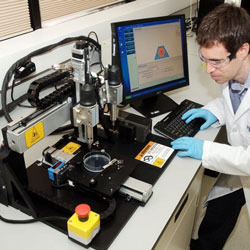Bioprinter Could Print Out New Tissue
by
Brendon Nafziger, DOTmed News Associate Editor | January 06, 2010

The 3D printer can
spit out simple
tissues, like blood vessels,
though one day the technology
could be used to create
whole organs
A printer that squirts out living cells into a three-dimensional matrix and that could one day help build new organs will be hitting research labs this spring.
Organovo, a San Diego, Calif.-based tissue regeneration company, plans to ship its first batch of "bioprinters" in March or April.
The printers, which create three-dimensional arrays of living cells, were co-developed by Invetech, a contract manufacturing company based out of San Diego and Melbourne, Australia.
"Building human organs cell-by-cell was considered science fiction not that long ago," said Dr. Fred Davis, president of Invetech, in a statement. "Through this clever combination of technology and science we have helped Organovo develop an instrument that will improve people's lives, making the regenerative medicine that Organovo provides accessible to people around the world."
TISSUE REGENERATION
The technology behind the printer grew out of tissue-regeneration research at Organovo, which has been developing a technique to "print" out functional blood vessels. Keith Murphy, Organovo's CEO, tells DOTmed News that a synthetic vasculature product, possibly to be used as a graft in coronary surgeries, could reach the clinic within two or three years.
While the initial focus of Organovo was on therapies derived from Gabor Forgacs' research, a physicist at University of Missouri-Columbia whose tissue-engineering breakthroughs led to the creation of the business, Murphy believes making the bioprinting technology more widely available will spur clinically, and commercially, useful research.
"As a business, we have two real goals: one is to build therapeutics and advance those to the market, and the second is to enable greater leaps and bounds in the whole market by getting this platform technology out there. We believe this technology will help research advance more quickly. If it does advance more quickly, we're going to be well positioned to partner with academic institutions to develop it," Murphy says.
HOW IT WORKS
The printer has two heads, one for delivering cells, and the other for printing a three-dimensional matrix, such as a hydrogel, in which to house the cells. According to Murphy, it lays out the cells like a laser printer, along stacked two-dimensional lines.
And the printing is precise, placing particles within 20 microns of the desired location.
Murphy says that, for now, the technology will be used to solve basic research problems in tissue engineering, such as building capillaries from scratch. But the hope is that one day, surgeons could use the device to create new tissues or organs for transplants.
"[Using the printer] they can actually make any piece of tissue you want," Murphy says. "For more complex structures, although we can create them, we don't have technology to get them going yet."
